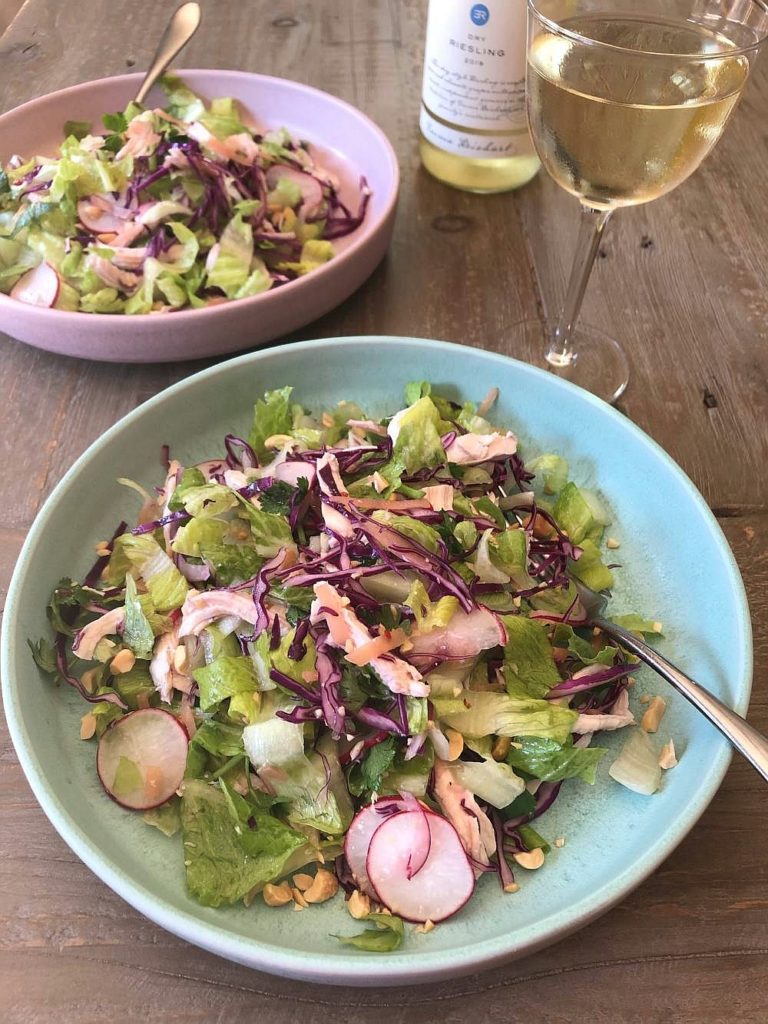
My father introduced me to drinking wine at a young age. Like my friend and cookbook author Kate Leahy, I started my wine appreciate before I was ten years old. Her parents took her to Napa. My dad mined the offerings at supermarkets and Trader Joe's. I drank lots of watered down red wine from cordial glasses. Kate started with slightly fermented grape juice at a winery. Over time, we both graduated to more complex wine offerings, with Kate developing an incredibly deep knowledge of wine and food and wine pairings. She has authored a number of complex restaurant cookbooks, including that of Burma Superstar in the Bay Area.
Her first solo cookbook just released and it's a marvelous, democratic work about learning to identify your personal wine style. Nowadays, her wine style is "charming and affordable", bottles she can generously share with friends in casual settings. She serves her wine with food -- unfussy preparations that she can throw together with ease. That's what you'll find in her cleverly titled book, Wine Style.
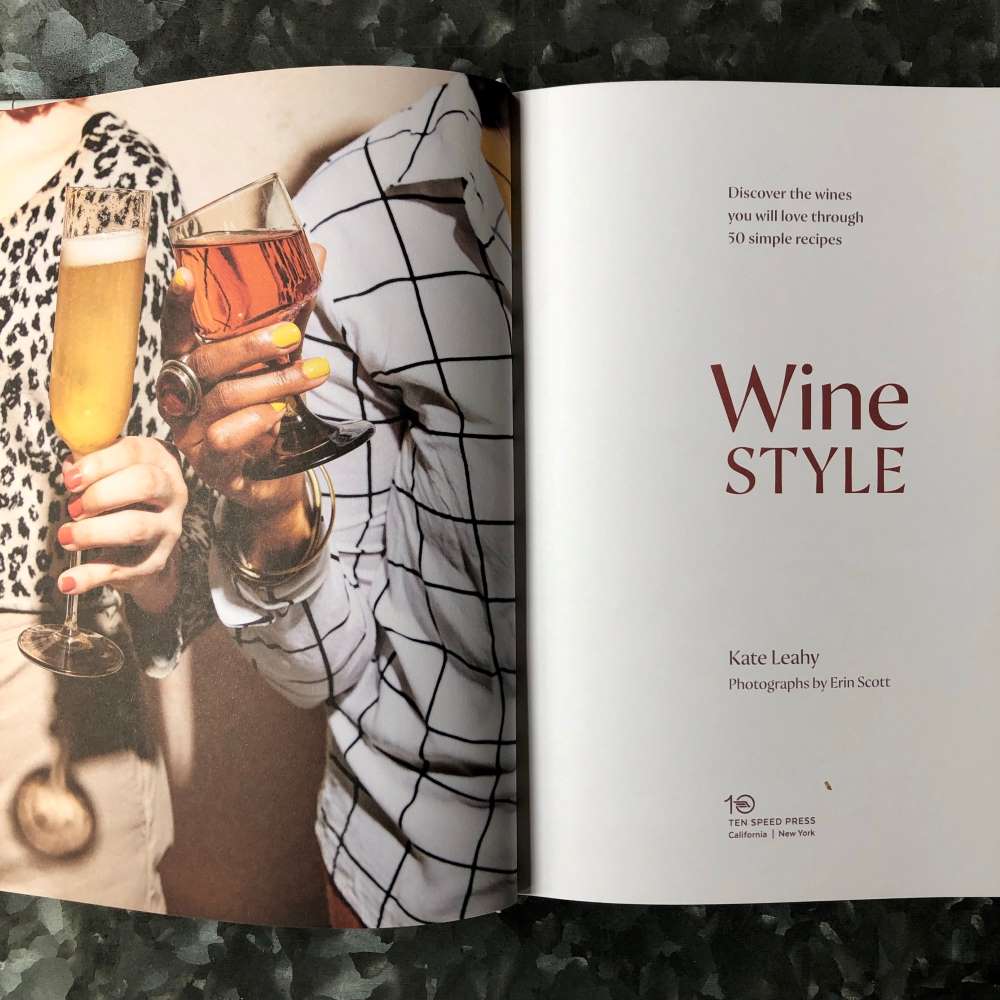
Anti-Wine Snob Advice
My wine education has come from drinking and asking questions. Wine experts are always eager to educate and I listen. Given that, my wine descriptions are not sophisticated (I once described a Riesling as tasting like gasoline and the people at the tasting room glowered at me; the wine maker agreed with me!). I lack a framework and full vocabulary for understanding wine. That's why the first 25 pages of Wine Style is worth the book's modest price.
For example, Kate offers succinct, humorous advice on how to understand wine textures and flavors. Wine pros often talk at length about acidity, tannins, body, fruitiness, earthiness, minerality, and herbal/floral notes. For sophomore-and-junior-level drinkers like me, I really want a concise explanation. Something that I can apply and keep learning from.
Explanations like this below sum things up nicely and offers terms that enable you to easily sense and describe your wine experience. Kate's wine buying section includes wine shops, independent grocers, discount stores, big-box retailers, and wine clubs. Kate encourages you to explore options. I shop at supermarkets as well as Kermit Lynch, a wine merchant in Berkeley. (Do forgive me for marking up books that I like.)
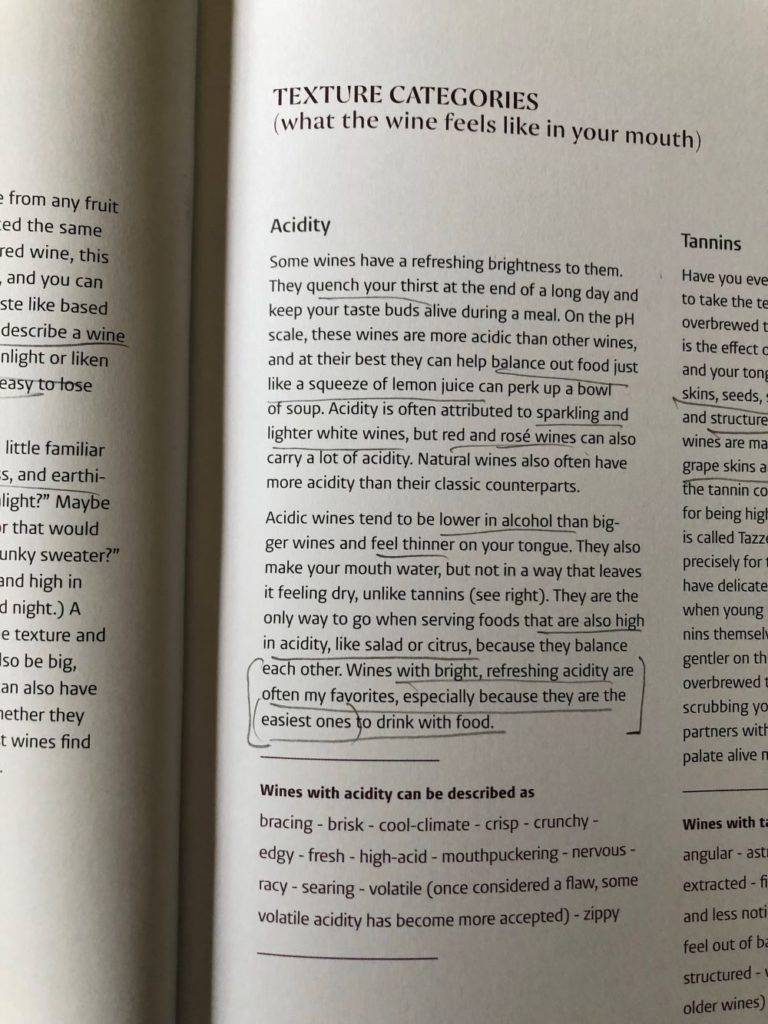
Asian Food and Wine Pairing
What about Asian food and wine? In Kate's book I read about a strange claim:
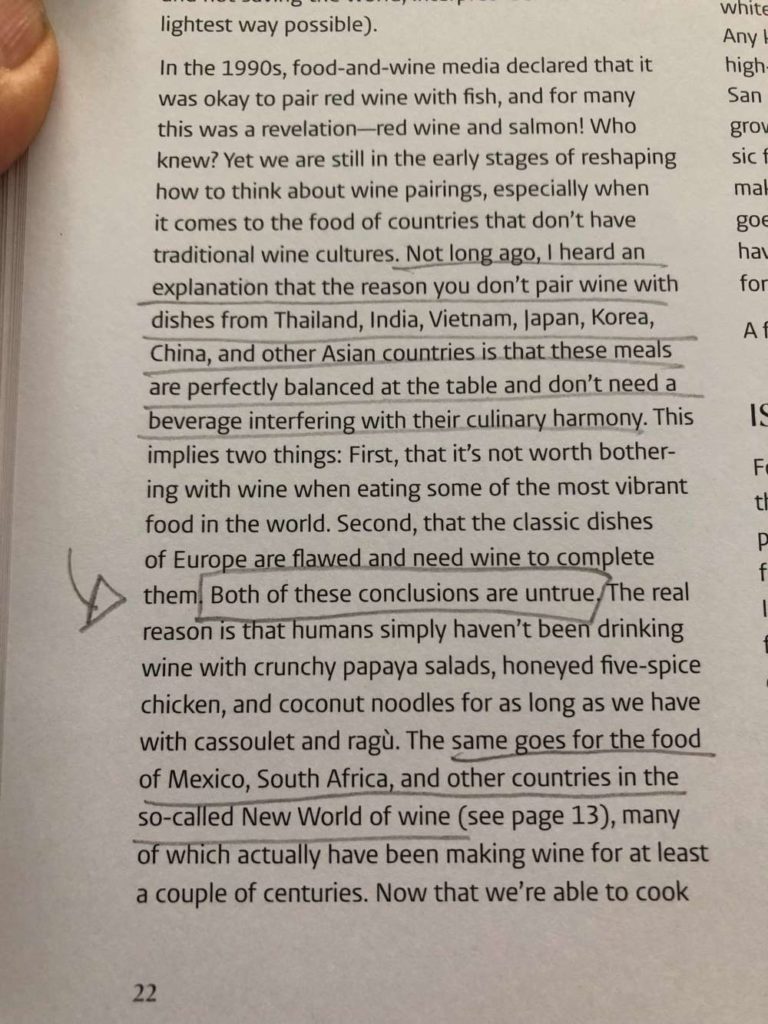
Seriously?!! Although higher octane than standard grape-based wine, Shaoxing rice wine has been brewed for centuries, with high quality ones served as beverages while others are used for cooking. At Chinese restaurants, I've witnessed innumerable parties of folks gathered around tables laden with fancy steamed, roasted and stir-fried and bottles of bold red wine. During the 1990s and early 2000s, wine pairings for Southeast Asian food skewed toward sweet wine.
Singaporean wine expert Edwin Soon wrote a 2009 book titled Pairing Wine with Asian Food filled with insights and tips. He once suggested Oloroso sherry to pair with my Vietnamese ribs in caramel sauce.
Like Edwin, Kate see no obstacles for pairing wine with Asian flavors. For a taste her sensibilities, I prepared a ginger and chicken salad, which riffs off of gin thoke, a ginger salad from the Burmese repertoire. Kate spent a fair time in Myanmar researching for the Burma Superstar cookbook so she knows something about the cuisine's foundations and parameters. (Check out the tea leaf salad from the book.)
Pairing Ginger and Chicken Salad with Wine
Asian salads like Kate's ginger and chicken salad are multilayered and complex. They are not boldly rich and salty tangy like a Caesar salad or creamy salty like a wedge salad dressed with blue cheese and bacon. The dressing has pickled ginger, raw shallot, lime juice, fish sauce, a touch of chile, and a bit of oil. As it sits, it develops a tart-sweet-salty-pungent quality.
I used well-aged homemade pickled ginger prepared Japanese style according to this recipe. It's not overly sweet and had umami with tang and slight heat. It may be from 2017 when I wrote and posted the pickled ginger recipe.
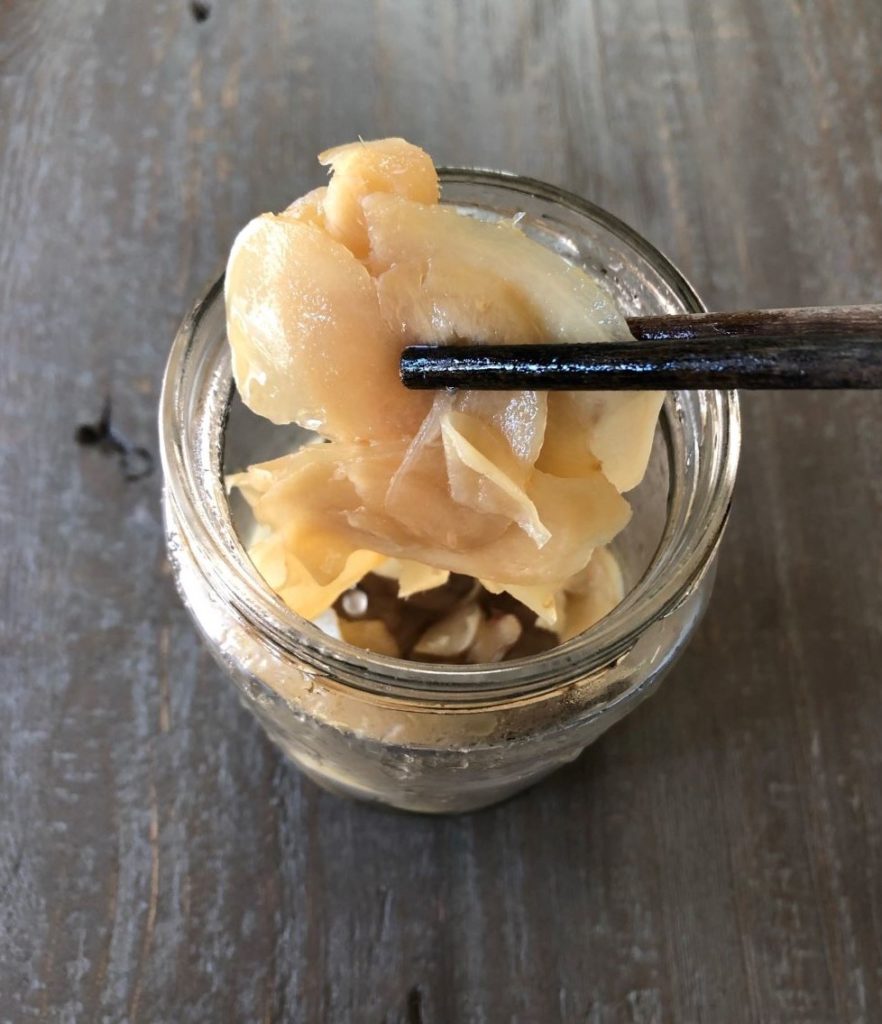
In the recipe headnote, Kate writes, "An off-dry Riesling works well with the pickled ginger, while Gruner Veltliner and Sauvignon blanc echo the citrus in the salad, reminding me of the salty lime sodas served in Southeast Asia." I had all those wine varietals on hand but went with a dry Riesling (in the top photo). I didn't want the slightly sweet off-dry flavors to overwhelm the ancient pickled ginger flavors.
The Emma Reichart Riesling is a $5 bottle from Trader Joe's. It's a friendly, "cheap and cheery" bottle that's perfect for midday meal like we had with the ginger chicken salad. The wine's bright crispness paired perfectly. I tasted the salad's layered flavors as well as that of the wine.
More Wine Styles
I mostly drink crisp white wines with low alcohol but am looking forward to advancing to the next chapter in Wine Style. It's about rich white wines like Chardonnay. I'm in the ABC ("anything but chardonnay") club but Kate will likely open my vistas.
I know nothing about orange wine and she's got a whole chapter on those. That's followed by casual picnic wines (gamay is a personal favorite) and reasonably serious reds (hello Cabernet Franc, my friend!). The final chapters focus on big reds like Merlot and Cabernet Sauvignon, and sweet wines such as port (a favorite of my dad's) and Banyuls. Oh, the book opens with bubbles, including champagne plus affordable cremant and cava; a sidebar explains how to decipher a sparkling wine's label and nerdy details like PSI.
There's a lot of wine education and fun packed into Wine Style, a smallish format book that retails for $22.
Make Ahead Tips
Back to the ginger chicken salad. I've made the salad twice this week, and will be putting it on rotation. Why? You can use leftovers like roast or rotisserie chicken! And, you may feature pan-fried tofu cubes for a lighter version. I prepped the salad in the morning while eating breakfast, then set it in the fridge for several hours until lunch time.
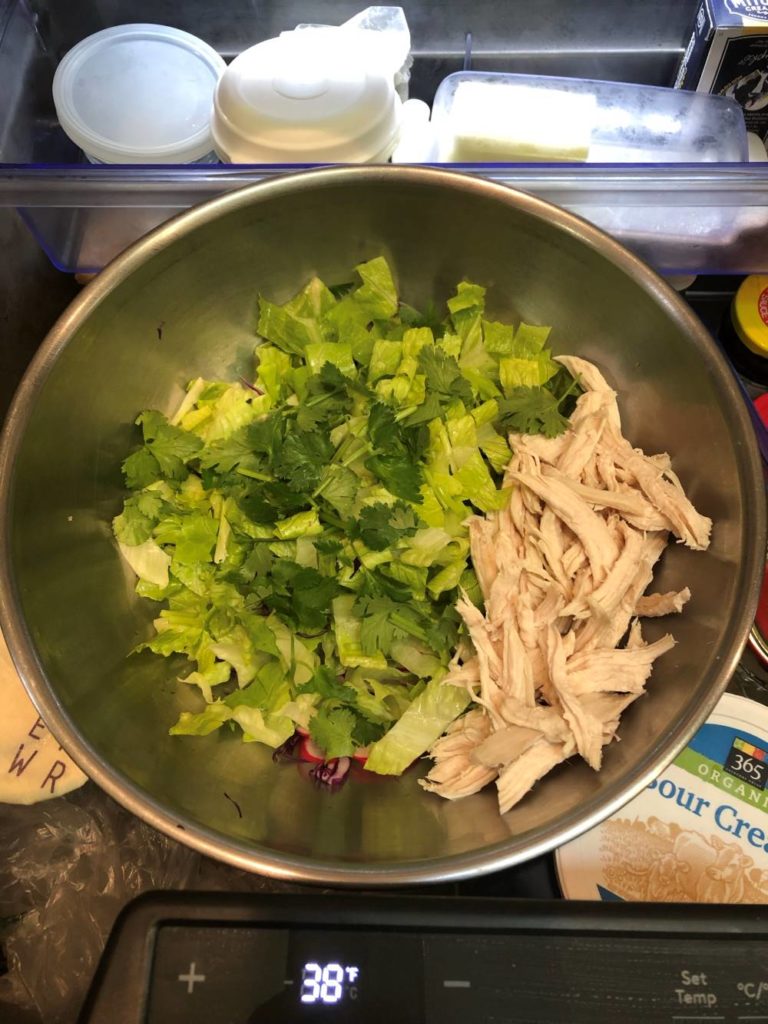
The dressing is best made the day of, but it could sit overnight, if you like.
Since more people are working from home, this would be a terrific midday meal. Go ahead and pour a glass for yourself!
Ginger Chicken Salad
Ingredients
- 2 8-ounce boneless skinless chicken breasts
- ¼ cup lightly packed pickled ginger, sliced as ribbons, plus 1 tablespoon pickling liquid
- 1 large shallot, thinly sliced, or ⅓ cup thinly sliced red onion
- 1 small garlic clove, minced and mashed
- 2 tablespoon fresh lime juice or apple cider vinegar
- 1 tablespoon fish sauce
- Pinch of red pepper flakes
- Fine sea salt or kosher salt
- 2 tablespoons neutral oil, such as canola or peanut
- 1 medium head romaine lettuce, sliced (about 6 cups)
- ¼ head green or red cabbage, shredded or very thinly sliced (about 2 cups)
- Handful of mixed greens (optional)
- 4 radishes, thinly sliced (optionial)
- ½ cup coarsely chopped cilantro sprigs or other tender fresh herbs
- ¼ to ⅓ cup coarsely chopped roasted peanuts or cashews
- 2 tablespoons toasted sunflower seeds (optional)
Instructions
- Put the chicken in a medium saucepan then add enough water to cover. Bring to a boil over high heat, then lower the heat and simmer gently for 12 to 15 minutes, until the chicken looks cooked through (test by insert the tip of a paring knife into the thickest part), or use an instant read thermometer, which should read about 165°F when done. Remove from the heat and let sit in the cooking water for 10 minutes more, then drain. When the chicken is cool enough to handle, use your hands to shred it into bite-size pieces.
- In a bowl, mix together the ginger and ginger pickling liquid, shallot, garlic, lime juice, fish sauce, red pepper flakes, plus a pinch of salt. Let sit for 5 minutes. Stir in the oil to form a vinaigrette, then taste and season with more salt or fish sauce, if desired.
- In a large serving bowl, mix together the lettuce cabbage, mixed greens, radishes, cilantro, and chicken. Season with 1 or 2 pinches of salt, toss, then add the vinaigrette and toss to coat well. Sprinkle the peanuts and sunflower seeds on top to finish. Serve immediately.













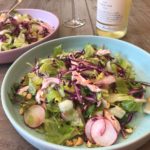




S McDowall says
Is the sliced ginger really meant to be kept whole? Not minced or sliced or anything? Seems like an odd way to serve it .. ??
Andrea Nguyen says
It is thinly sliced. I realize it's confusing because the ingredient line reads like this: "1/4 cup packed thinly sliced pickled ginger plus 1 tablespoon... ". This means you thinly slice the already thinly sliced ginger then you measure 1/4 packed up. If the ingredient line was written this way: "1/4 packed pickled ginger, thinly sliced, plus 1 tablebspoon..." it would look awkward. So yes, the ginger is thinly sliced. Welcome to the cookbook writing. A copy editor makes these sorts of changes. Sigh...
BUT, in light of our conversation here, I just tweaked the ingredient line to say: 1/4 cup lightly packed pickled ginger, sliced as ribbons, plus 1 tablespoon..."
Thank you for asking and I hope this clarified things.
Maureen O'Reilly says
What a coincidence, I gave that book to my husband last week as one of his anniversary presents and after I looked it over, decided to return it. The majority of wines seemed to be European and the recipes British oriented. I love European wines but can't afford them! And Brit cuisine is just not my fave. I haven't sent it back and now in light of this article I guess I should keep it. I trust you and your recommendations.
Andrea Nguyen says
I hope you keep the book Maureen. There are some very cool recipes in the book. I think you can crib from the book and not spend a fortune. In the front, Kate discusses value shopping. Cheers to you and your husband on your anniversary!